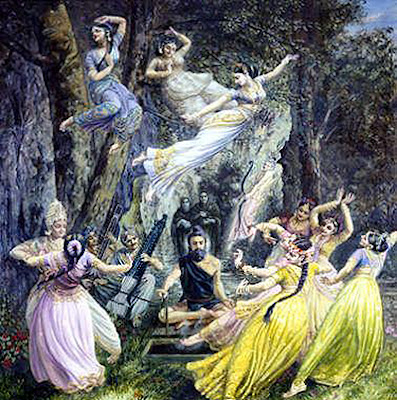Question: I’ve asked many devotees why they have sikhas and they all don’t seem to know exactly why… is there any scripture behind why? I couldn’t find any. All I found was a bunch of statements as to why without scriptural support.
The shikha is a symbol of Vedic culture, a.k.a “Varṇāśrama Dharma.” These days it is a custom mainly observed only by brahmaṇas (perhaps because they seem to have the most to gain by reminding people about what they consider Varṇāśrama Dharma?). [A Concise Encyclopedia of Hinduism, Klaus K. Klostermaier, ISBN 1-85168-175-2]
In most ancient cultures, children have a pre-pubescent hairstyle shaving most, but not all of the hair from the head. In Vedic culture this occurred at a special ceremony (cudakarma saṁskāra) at the age of three. Cutting hair at this age symbolizes encouraging the child to establish a firm identity distinct from its mother. The hair which was left since birth (and was therefore connected with being in the mother’s womb) is shaved off, and new hair grows, symbolizing the emergence of the new individual.
As an extrapolation, shaving the head at some other time in life also symbolizes making a break from a former situation and developing new roots in a new situation. Hare Krishna’s use it in this manner – shaving the head disconnects the disciple from the former sense of identity, and allows them to establish a new identity as a member of the Krishna society, or, better, as a spiritual entity.
Why not Shave the Whole Thing?
Not all the hair is shaved. The reason is that it was considered dangerous to shave the crown of the head, since an important nadi (energy channel) flowed there, and shaving the hair at this point would disturb that channel.
Different clans had different styles. Atri and Kasyap clans keep two tufts, for example. Vasishta clans keep one.
Why KEEP Shaving it?
If this hairstyle is kept throughout life it shows extreme dedication to religious principles. This may be another reason why brahmaṇas (priests) adopted it far more than any others.
Should it be Tied in a Knot?
Disheveled hair is rude because it symbolizes neglect and therefore misfortune and “inauspiciousness,” so the shikha is kept tied except in times of mourning (during which it is appropriate to neglect ones appearance).
Is it Only for Men?
The ritual is not reserved for males, but over time it has become more popular among males and today definitely carries the conventional connotation of being a “male thing.” In ISKCON, for example, it would be very, very unconventional to see a woman with a śikha.
What Does the Word Literally Mean?
The word śikha simply means “summit.” The crown of the head is the summit of the body, the highest point. That’s why it is called a śikha. Some claim that Bhāgavatam 6.8.8 refers to the necessity of having a śikha but this is a context-abusive interpretation. In context, the śikha mentioned in this verse is simply the top of the head.
Does it allow God to pull you to heaven?
No. When you die your body rots or is burned or eaten. Your body doesn’t go to “heaven” – so it doesn’t matter if it has a convenient “handle” or not. Nor does God really need to “reach down” to grab you. He is, after all, in your core as paramātmā, not over your head as Zeus on a mountaintop.
This is really a ridiculous idea.
Is it a Vaiṣṇava Symbol?
It’s a symbol of Vedic culture, which includes Vaiṣṇava culture among its many branches.
Among Śrī Caitanya Mahaprabhu’s followers, some had śikha, some did not. Mahāprabhu himself did not keep a śikha. While married, he kept long hair. When he accepted sanyassa he shaved his head entirely, because that was the tradition in the sect from which he received sannyasa (a monistic sect, with the complete shaving symbolizing rejection of everything including traditions).
Then why do Hare Krishna / ISKCON Devotees Make a Big Deal of It?
Much of ISKCON culture is rooted in practices established by Śrī Bhaktisiddhānta Sarasvatī, the guru of ISKCON’s founder. In his religious organization, the Gauḍīya Maṭh, He established several practices which loudly proclaimed Vaiṣṇava’s to be equivalent to brahmāṇas, regardless of their birth caste. One of these practices was giving the “sacred thread” (a thread worn over the left shoulder) to his disciples. Another was shaving their heads with śikha. Both of these, thread and śikha, had over time come to be considered symbols of only the brahmana caste (when in truth they are appropriate for any member of a Vedic Varṇāśrama culture). Indeed, in ISKCON the thread is usually referred to as a “brahmaṇa’s thread” – though the correct term for it is upavīta (meaning a pseudo-clothing, an abbreviated form of clothing), or yajña-upavīta (something to wear to a religious ceremony so that you are not entirely barechested).
In any case, by giving thread and śikha to his disciples of various castes, Bhaktisiddhānta made a huge, controversial social and spiritual statement: “Vaiṣṇavas are automatically as good as brahmaṇas.”
Śrīla Prabhupāda carried over those practices into ISKCON.
As an aside: ISKCON’s use of saffron cloth and the prominence of varṇa and especially āśramas (particularly brahmacārī and sannyāsa) in the context of Gauḍīya Vaiṣṇava Sādhana-Bhakti is also a result of Bhaktisiddhānta’s socio-spiritual statements.
Tagged:
Hare Krishna,
hare krishna hair,
shika,
sikha 








































